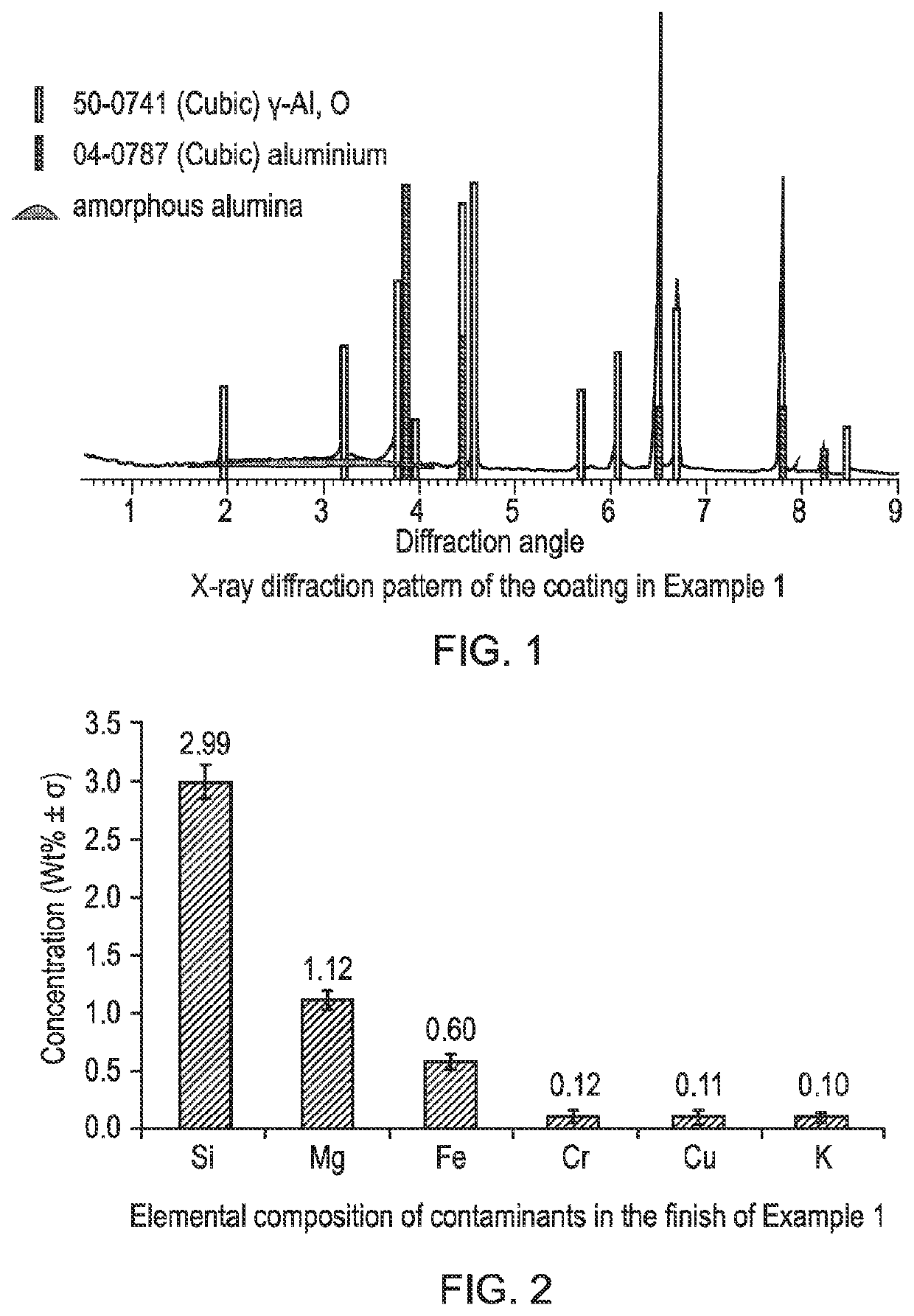Durable white inorganic finish for aluminium articles
a technology of inorganic finish and aluminium, which is applied in the direction of electrolytic coating, surface reaction electrolytic coating, coating, etc., can solve the problems of low stability of electrolyte systems, alloys with low strength, and limiting application of alloys
- Summary
- Abstract
- Description
- Claims
- Application Information
AI Technical Summary
Benefits of technology
Problems solved by technology
Method used
Image
Examples
example 1
[0042]An article of aluminium 6082 alloy was placed in an electrolyte bath containing a solution of 2 wt % ammonium phosphate, 1 wt % acetic acid, 1 wt % potassium hydroxide and 1 wt % sodium tetrafluoroborate. Anodic voltage pulses were applied with a voltage of 480V, the discharge power was maintained below 15 W, and the process was continued until the coating reached 40 μm thickness. At the end of the process, the anodic breakdown voltage of the coating in the bath was measured to be 290V.
[0043]X-ray diffraction was performed in Bragg-Brentano geometry, from 5-90° 2q, with 2 second, 0.02° steps in a 40 kV, 40 mA Phillips PW1830 Diffractometer. The resulting spectrum (FIG. 1) shows that the coating consists primarily of gamma phase alumina with a small amount of amorphous material. The coating had a white appearance and luminosity was measured on a Konica Minolta spectrometer using the CIE L*a*b* colour space to be 82.6%.
[0044]The elemental composition of the finish was measured u...
example 2
[0045]An article of 2219 alloy, containing nominally 6 wt % Cu, was placed in a bath containing a solution of 3 wt % trisodium phosphate, 1 wt % ammonium hydroxide, 1 wt % citric acid and 0.5 wt % sodium fluoride and anodic pulses of 350V were applied, alternated with cathodic pulses of 100V. Discharge power was maintained below 15 W by adjusting the duration of the pulses. The process was continued until the coating thickness reached 15 μm. At the end of the process, the anodic breakdown voltage of the coating in the electrolyte was measured to be 195V. The resulting coating was X-rayed and found to comprise over 90 wt % gamma alumina. Typical plasma anodising of such an alloy would produce a dark grey to black coating due to the high amount of copper in the alloy. However, in this case, luminosity (L*) was measured at 82.2%.
example 3
[0046]An article of 1050 alloy was placed in the same bath as Example 2 and bipolar pulses with 400V anodic voltage and 100V cathodic voltage were applied. Discharge power was maintained below 15 W by adjusting the duration of the pulses. The process was continued until the coating thickness reached 20 μm. At the end of the coating process, the anodic breakdown voltage of the coating was measured to be 192V. Luminosity (L*) was measured at 87.1%.
PUM
| Property | Measurement | Unit |
|---|---|---|
| anodic breakdown voltage | aaaaa | aaaaa |
| porosity | aaaaa | aaaaa |
| diameter | aaaaa | aaaaa |
Abstract
Description
Claims
Application Information
 Login to View More
Login to View More - R&D
- Intellectual Property
- Life Sciences
- Materials
- Tech Scout
- Unparalleled Data Quality
- Higher Quality Content
- 60% Fewer Hallucinations
Browse by: Latest US Patents, China's latest patents, Technical Efficacy Thesaurus, Application Domain, Technology Topic, Popular Technical Reports.
© 2025 PatSnap. All rights reserved.Legal|Privacy policy|Modern Slavery Act Transparency Statement|Sitemap|About US| Contact US: help@patsnap.com

